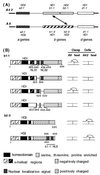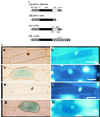A role for heterodimerization in nuclear localization of a homeodomain protein
- PMID: 9600947
- PMCID: PMC27639
- DOI: 10.1073/pnas.95.11.6228
A role for heterodimerization in nuclear localization of a homeodomain protein
Abstract
The A mating type genes of the mushroom Coprinus cinereus encode two families of dissimilar homeodomain proteins (HD1 and HD2). The proteins heterodimerize when mating cells fuse to generate a transcriptional regulator that promotes expression of genes required for early steps in sexual development. In previous work we showed that heterodimerization brings together different functional domains of the HD1 and HD2 proteins; a potential activation domain at the C terminus of the HD1 protein and an essential HD2 DNA-binding motif. Two predicted nuclear localization signals (NLS) are present in the HD1 protein but none are in the HD2 protein. We deleted each NLS separately from an HD1 protein and showed that one (NLS1) is essential for normal heterodimer function. Fusion of the NLS sequences to the C terminus of an HD2 protein compensated for their deletion from the HD1 protein partner and permitted the two modified proteins to form a functional transcriptional regulator. The nuclear targeting properties of the A protein NLS sequences were demonstrated by fusing the region that encodes them to the bacterial uidA (beta-glucuronidase) gene and showing that beta-glucuronidase expression localized to the nuclei of onion epidermal cells. These observations lead to the proposal that heterodimerization regulates entry of the active transcription factor complex to the nucleus.
Figures



Similar articles
-
Heterodimerization between two classes of homeodomain proteins in the mushroom Coprinus cinereus brings together potential DNA-binding and activation domains.Gene. 1996 Jun 12;172(1):25-31. doi: 10.1016/0378-1119(96)00177-1. Gene. 1996. PMID: 8654986
-
An N-Terminal Dimerization Domain Permits Homeodomain Proteins To Choose Compatible Partners and Initiate Sexual Development in the Mushroom Coprinus cinereus.Plant Cell. 1995 Jun;7(6):773-83. doi: 10.1105/tpc.7.6.773. Plant Cell. 1995. PMID: 12242384 Free PMC article.
-
A chimeric homeodomain protein causes self-compatibility and constitutive sexual development in the mushroom Coprinus cinereus.EMBO J. 1994 Sep 1;13(17):4054-9. doi: 10.1002/j.1460-2075.1994.tb06722.x. EMBO J. 1994. PMID: 7915674 Free PMC article.
-
Molecular genetics of sexual development in the mushroom Coprinus cinereus.Bioessays. 2002 May;24(5):449-59. doi: 10.1002/bies.10083. Bioessays. 2002. PMID: 12001268 Review.
-
The vitamin D hormone and its nuclear receptor: molecular actions and disease states.J Endocrinol. 1997 Sep;154 Suppl:S57-73. J Endocrinol. 1997. PMID: 9379138 Review.
Cited by
-
A deviation from the bipolar-tetrapolar mating paradigm in an early diverged basidiomycete.PLoS Genet. 2010 Aug 5;6(8):e1001052. doi: 10.1371/journal.pgen.1001052. PLoS Genet. 2010. PMID: 20700437 Free PMC article.
-
Genome sequence of the model mushroom Schizophyllum commune.Nat Biotechnol. 2010 Sep;28(9):957-63. doi: 10.1038/nbt.1643. Epub 2010 Jul 11. Nat Biotechnol. 2010. PMID: 20622885
-
Life history and developmental processes in the basidiomycete Coprinus cinereus.Microbiol Mol Biol Rev. 2000 Jun;64(2):316-53. doi: 10.1128/MMBR.64.2.316-353.2000. Microbiol Mol Biol Rev. 2000. PMID: 10839819 Free PMC article. Review.
-
Nuclear localization of Schizosaccharomyces pombe Mcm2/Cdc19p requires MCM complex assembly.Mol Biol Cell. 1999 Dec;10(12):4043-57. doi: 10.1091/mbc.10.12.4043. Mol Biol Cell. 1999. PMID: 10588642 Free PMC article.
-
Mating-Type Locus Organization and Mating-Type Chromosome Differentiation in the Bipolar Edible Button Mushroom Agaricus bisporus.Genes (Basel). 2021 Jul 16;12(7):1079. doi: 10.3390/genes12071079. Genes (Basel). 2021. PMID: 34356095 Free PMC article.
References
-
- Casselton L A. In: The Filamentous Fungi, Fungal Development. Smith J E, Berry D R, editors. Vol. 3. London: Edward Arnold; 1978. pp. 275–297.
-
- Kües U, Richardson W V J, Tymon A M, Mutasa E S, Göttgens B, Gaubatz S, Gregoriades A, Casselton L A. Genes Dev. 1992;4:568–577. - PubMed
LinkOut - more resources
Full Text Sources

